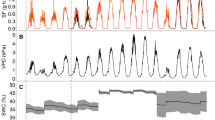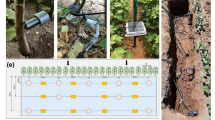Abstract
The sensitivity of stem diameter variations (SDV) measured with linear variable transducer (LVDT) sensors as indicators of plant water status in tomato was evaluated. Two tomato crops were grown sequentially in a sandy loam soil in an unheated plastic greenhouse. These were an autumn–winter tomato crop (autumn crop) and a spring–summer tomato crop (spring crop). One drying cycle of 61 days was imposed to the autumn crop in winter at 92 days after transplanting (DAT). Two drying cycles, each of 29 days, were applied to the spring crop, to young (58 DAT) and mature plants (121 DAT). For each drying cycle, four replicate plots did not receive irrigation, and four were well watered. During each drying cycle, LVDT sensors continuously measured SDV, and daily measurements were made of leaf (Ψ leaf) and stem water potential (Ψ stem). SDV data was interpreted using the SDV-derived indices, maximum daily shrinkage (MDS) and stem growth rate (SGR). The response of SDV-derived indices to water deficit differed with (1) climatic conditions during stress imposition and (2) crop age. In the winter drying cycle of the autumn crop, the responses of the SDV-derived indices to soil drying were relatively small and slower than Ψ leaf and Ψ stem. Under warmer conditions, the SDV-derived indices were much more responsive to soil drying. In rapidly growing young plants, where SDV was characterized by high SGR and small MDS, SGR was the most sensitive SDV-derived index. In more mature plants with little stem growth, MDS was the most sensitive SDV-derived index. In mature plants grown in warm to hot conditions, MDS (1) responded at a similar time or earlier than Ψ leaf and Ψ stem and (2) had larger “signal” values (ratio of values from unwatered to control plants) than Ψ leaf and Ψ stem. However, there was appreciably more “noise” (coefficient of variation, CV) associated with the SDV-derived indices, giving lower “sensitivity” values, determined from “signal” to “noise” ratios, than for Ψ leaf and Ψ stem. Regression analysis between MDS of well-watered plants and climatic variables gave best results for a linear relationship between MDS and daily maximum vapor pressure deficit. There were strong linear relationships between MDS and Ψ leaf for each drying cycle. The slopes of these relationships differed with crop age indicating that there was no constant relationship between MDS and Ψ leaf for a whole season. Overall these results demonstrated that MDS and SGR can be sensitive indicators of the water status of tomato crops under conditions of moderate to high evaporative demand. However, the variability associated with the SDV-derived indices and the changing MDS–Ψ leaf relationship with crop age represent major issues regarding the development of irrigation scheduling protocols for tomato.







Similar content being viewed by others
References
Castilla N (2005) Invernaderos de Plástico, Tecnología y Manejo. Mundi-Prensa, Madrid, p 462
Cohen M, Valancogne C, Dayau S, Ameglio T, Cruiziat P, Archer P (1997) Yield and physiological responses of walnut trees in semi-arid conditions: application to irrigation scheduling. Acta Hortic 449:273–280
Cohen M, Savé R, Biel C, Marfà O (1998) Simultaneous measurements of water stress with LVDT sensors and electrotensiometers: application in pepper plants grown in two types of perlite. Acta Hortic 421:193–199
Fabeiro C, Martín De Santa Olalla F, De Juan JA (2002) Production of muskmelon (Cucumis melo, L.) under controlled deficit irrigation in a semi-arid climate. Agric Water Manage 54:93–105
Fereres E, Goldhamer DA (2003) Suitability of stem diameter variations and water potential as indicators for irrigation scheduling of almond trees. J Hortic Sci Biotech 78:139–144
Gallardo M, Thompson RB, Valdez LC, Pérez C (2004) Response of stem diameter to water stress in greenhouse-grown vegetable crops. Acta Hortic 664:253–260
Garnier E, Berger A (1985) Effect of water stress on stem diameter changes of peach trees growing in the field. J Appl Ecol 23:193–209
Génard M, Fishman S, Vercambre G, Huguet JG, Bussi C, Besset J, Habiv R (2001) A biophysical analysis of stem and root diameter variations in woody plants. Plant Physiol 126:188–202
Goldhamer DA, Fereres E (2001) Irrigation scheduling protocols using continuously recorded trunk diameter measurements. Irrig Sci 20:115–125
Goldhamer DA, Fereres E (2004) Irrigation scheduling of almonds trees with trunk diameter sensors. Irrig Sci 23:11–19
Goldhamer DA, Fereres E, Mata M, Girona J, Cohen M (1999) Sensitivity of continuous and discrete plant and soil water status monitoring in peach trees subjected to deficit irrigation. J Am Soc Hort Sci 124:437–444
Huguet JG, Li SH, Lorendeau JY, Pelloux G (1992) Specific micromorphometric reactions of fruit trees to water stress and irrigation scheduling automation. J Hort Sci 67:631–640
Intrigliolo DS, Castel JR (2004) Continuous measurement of plant and soil water status for irrigation scheduling in plum. Irrig Sci 23:93–102
Katerji N, Schoch PG, Rimgoto P, L’Hôtel JC (1990) Diagnostic des périodes de contrainte hydrique chez des plantes d´aubergine cultivées en serre, au moyen des microvariations des tiges. Agronomie 10:541–549
Katerji N, Hamdy A, Raad A, Mastrorilli M (1991) Conséquence d´une contrainte hydrique appliquée à différents stades phénologiques sur le rendement des plantes de poivron. Agronomie 11:679–687
Kinet JM, Peet MM (1997) Tomato. In: Wien HC (ed) The physiology of vegetable crops. CAB International, Wallingford, pp 207–258
Klepper B, Taylor HM, Huck MG, Fiscus EL (1973) Water relations and growth of cotton in drying soil. Agron J 65:307–310
Kozlowski TT (1976) Shrinking and swelling of plant tissue. In: Kozlowski TT (ed) Water deficit and plant growth, vol 3. Academic, New York, pp 1–64
Marsal J, Gelly M, Mata M, Arbonés A, Rufat J, Girona J (2002) Phenology and drought affects the relationship trunk shrinkage and midday stem water potential of peach trees. J Hort Sci Biotech 77:411–417
McBurney T, Costigan PA (1984) The relationship between stem diameter and water potentials in stems of young cabbage plants. J Exp Bot 35:1787–1793
McCutchan H, Shackel K (1992) Stem-water potential as a sensitive indicator of water stress in prune trees (Prunus domestica L. cv. French). J Am Soc Hort Sci 117(4):607–611
Mitchell JP, Shennan C, Grattan SR (1991) Developmental changes in tomato fruit composition in response to water deficit and salinity. Physiol Plant 83:177–185
Molz FJ, Klepper B (1973) On the mechanism of water-stress-induced stem deformation. Agron J 65:304–306
Moriana A, Fereres E (2002) Plant indicators for scheduling irrigation of young olive trees. Irrig Sci 21:83–90
Moriana A, Fereres E (2004) Establishing reference values of trunk diameter fluctuations and stem water potential for irrigation scheduling of olive trees. Acta Hort 664:407–412
Naor A (2000) Midday stem water potential as a plant water stress indicator for irrigation scheduling in fruit trees. Acta Hort 537:447–454
Orgaz F, Fernández MD, Bonachela S, Gallardo M, Fereres E (2005) Evapotranspiration of horticultural crops in an unheated plastic greenhouse. Agric Water Manage 72:81–96
Remorini D, Massai R (2003) Comparison of water status indicators for young peach trees. Irrig Sci 22:39–46
Roberts MJ, Long SP, Tieszen LL, Beadle CL (1985) Measurement of plant biomass and net primary production. In: Coombs J, Hall DO, Long SP, Scurlock JMO (eds) Techniques in bioproductivity and photosynthesis. Pergamon Press, New York, pp 1–19
Schoch PG, L’Hôtel JC, Brunel B (1988) Variations of stem diameter, leaf stomatal resistance and net photosynthetic rate in egg-plants affected by water stress. Photosynthetica 22:477–482
Thompson RB, Gallardo M, Gimenez C (2002) Risk of nitrate leaching from the horticultural industry of Almeria, Spain. In: Proceedings of the VII congress of the European Society for Agronomy, Cordoba, Spain, July 2002, pp 775–776
Valdez LC (2005) Medidas continuas del estado hídrico de la planta y del suelo para la programación del riego en cultivos hortícolas de invernadero. PhD thesis, Universidad de Almería, pp 237
Wittwer SH, Castilla N (1995) Protected cultivation of horticultural crops worldwide. HortTechnology 3:6–19
Acknowledgements
This work was part of the project AGL2001-2068 funded by the Spanish Ministry of Science and Technology and FEDER. We thank the Cajamar “Las Palmerillas” research station for the provision of facilities to undertake this work and for the assistance given during the conduct of the work. We acknowledge the constructive and helpful contribution of the two anonymous referees.
Author information
Authors and Affiliations
Corresponding author
Additional information
Communicated by P. Waller
Rights and permissions
About this article
Cite this article
Gallardo, M., Thompson, R.B., Valdez, L.C. et al. Use of stem diameter variations to detect plant water stress in tomato. Irrig Sci 24, 241–255 (2006). https://doi.org/10.1007/s00271-005-0025-5
Received:
Accepted:
Published:
Issue Date:
DOI: https://doi.org/10.1007/s00271-005-0025-5




